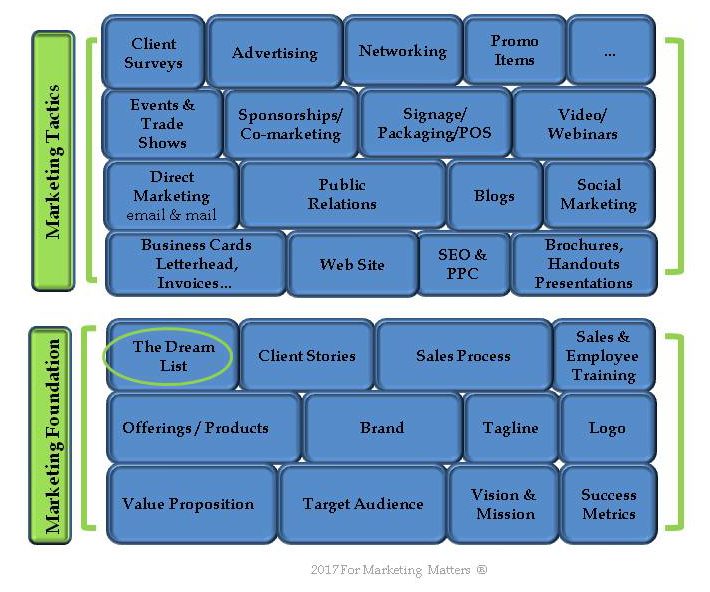What is your company’s marketing goals?
Awareness? Lead Generation? Retention?
No matter your goal, you need this foundational element in place. Unfortunately most SMBs (small and mid-sized businesses) do not have a solid Dream List. When we initially engage and assess a client’s foundation, the Dream List is commonly non-existent or weak. Read on to learn what a Dream List is, why you need one for your business and tips for organizing data to get this key asset in place.
What’s a Dream List?
It is For Marketing Matters’ term for your critical marketing and sales asset. It is a thorough, current, sortable list of customers/clients, prospects, partners and referrers. As shown below, The Dream List is one of 13 foundational elements to have in place for your business to be on solid footing. It’s a company asset that needs to be developed and maintained to enable targeted, effective marketing.
How many of you are finalizing a plan for a holiday card mailer or email? Was it easy to determine a count? Are you planning a customer event and can’t easily determine who to invite? Targeting and segmenting is not just for big companies, SMBs need to be able to target too!

What needs to be in your Dream List?
Below is a list of recommended data to organize and house in one place. I am a nerd so I think in terms of columns and rows. Be sure to have every field be one data element; in other words, first name in one field, last name in a separate field. Emails in one field as opposed to address containing a mix of email addresses and physical addresses. This recently happened when a sales person reviewed their draft Dream List with me. Not particularly useful!
- Client/customer information: Company name, mailing address (parse each field), First Name, Last Name, Title, email address,phone number for every contact. C for Client/Customer.
- Prospect information: same information as above but noted in Type column or field P for prospect
- Partners – if your business relies on partners then capture all relevant info using the same fields as the above and clearly differentiate in coding to easily sort and know these are Partners and not Prospects.
- Referrers – same information as the above for key referral sources with Type column or field as R.
- Other potential fields you may want to capture include product/service categories. This can be useful for upsell and cross sell to easily identify clients who could be good targets for a complementary product or service.
Do I need expensive software?
No. A Microsoft Excel spreadsheet can be sufficient to combine all data that is strewn across your company including invoicing and sales. Identify all potential sources and start exporting content as a way to organize in unique columns. It may make sense over time to evaluate software solutions but depending on how many contacts you need to organize and sort, Excel may be adequate.
Sometimes, where the information is stored is less critical than having clear ownership. The bigger challenge for your business may be a classic case of garbage in, garbage out. Establishing standards, processes and accountability can be half the battle.
Whether you choose to have software such as salesforce.com, rely on your email software such as Constant Contact or manage in Excel, the key is ownership and management. Someone needs to lead the charge to get the data set up consistently and then maintain it. That is a role we gladly take on for our clients. Once it is set up, what a beautiful thing it is to have this asset in place to fuel marketing efforts. Whether you are focused on awareness or retention or lead generation, you NEED a workable, useful asset in place.
Tips: Establish standards by field to assist in consistency of data. If using Excel, create drop downs where possible to make input easy and to keep it consistent.
The Power of a Dream List:
Below are two examples of how a Dream List then should be leveraged for targeted marketing efforts.

Example 1: Email Marketing
Last week, we were cranking to prepare emails intended to reach 4 distinct audiences for a client using Mail Chimp. We had recently taken over as the marketing department and had established an aggressive schedule to be out in advance of the Thanksgiving holiday. As the team was writing content, developing offers, setting up coupon codes, updating website content and graphics and designing the email content, the Dream List was being analyzed. Unfortunately the four segments were not in place. We needed to get the Dream List in place or the strategy could not be executed.
So, we organized all the various segments to combine, dedupe and build the 4 fundamental groups we needed to reach:
- Product Category 1 Customers
- Product Category 1 Prospects
- Product Category 2 Customers
- Product Category 2 Prospects
With these segments established, we can reach the right audience with the right message and offer. We will consistently maintain these segments and be able to efficiently leverage the Dream List for all future email marketing efforts.
Example 2: Social Media Strategy
We don’t recommend clients incorporate social media a solid foundation is in place. How can you be effective via social media if your value proposition is weak, you do not have a well defined ideal target audience and your offerings are under-developed? For our clients who are about to embark on social media in the coming month, we are focused on getting their Dream List created, cleaned up and ready in advance of launching the social media strategy. The Dream List is an incredible asset to our social media team to effectively build followers and similar to email marketing, reach the right audience with the right message.
A priority for two of our clients right now is helping them get their Dream List organized, cleaned up and coded. With this in place, our team will be able to effectively develop and post content on LinkedIn, Twitter and Facebook and build followers and engagement by channel.
Final Tip for Building Your Dream List – Code Each Contact:
Coding is a simple, yet powerful column in the Dream Lists we build and maintain. What do I mean by coding?
Do all of your clients meet your definition of an ideal client? Probably not. Be sure to use a field to capture relative importance of your clients to your business. We recommend three simple ‘buckets’ to code: A,B or C. As are ideal clients. B are decent, not ideal but have the potential to be ideal or “A” over time. C clients are lousy; we affectionately refer to them as “pond scum” and recommend there is a plan to minimize investment or to get rid of them over time. Why keep them in the Dream List? So you can identify them to exclude from select marketing and sales efforts.
Recommendation: Code every contact in your company’s Dream List as an A, B or C. Do the same for your prospects.

More time and effort should be put into servicing and retaining your A clients and converting your A prospects to clients. Use the Dream List coding to prioritize where time is spent, who you invite to select client events and where you invest in your business. When budgets are being evaluated, use the A and B coding to determine counts.
Now with this work done, imagine how easy it would be to quickly generate a list of your A clients who you want to send a gift to for the holiday season!
Take Action Now to Strengthen Your Company’s Foundation:
Ask yourself: Could you confidently reach your existing customer base via email? Could you confidently reach your prospects via email to offer them an incentive to sign on with you before December 31st?
Your Dream List as shown in the visual above is a foundational element for any business. It is marketing 101, basic blocking and tackling. If you are investing in marketing without a Dream List, you likely are wasting time and money. if you have one in place and it needs to be cleaned up and organized, start chipping away at it. Many years ago, an FMM client did not have a Dream List. Each sales person kept his contacts on his laptop. Within months, we consolidated all data and established a Dream List with over 6,000 contacts of customers, prospects and partners. This Dream List was used for all communications and it established a company asset that remained in tact in the case of sales person turnover.
Whether your goal is to increase awareness, leads or improve retention, establish a supporting goal to get your data in order! Your marketing efforts will be more effective and efficient and you will be building an asset for your company.
No need to overcomplicate the effort. An Excel spreadsheet is a start. Segments in MailChimp is a start. Business cards stacked on your desk – not so much!
As is typical with so many things, we avoid efforts that can be mind numbing. As a roll-up-your-sleeves, get ‘er done type of marketing team, we build the Dream List, maintain it and convert it into a company asset that generates return.
Think of how great it would be to confidently reach the right audience with the right message at the right time. It’s a beautiful thing.

